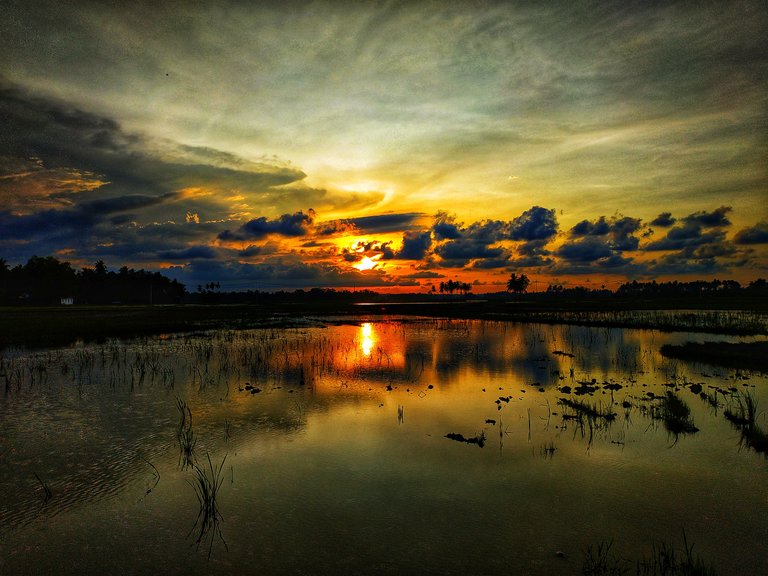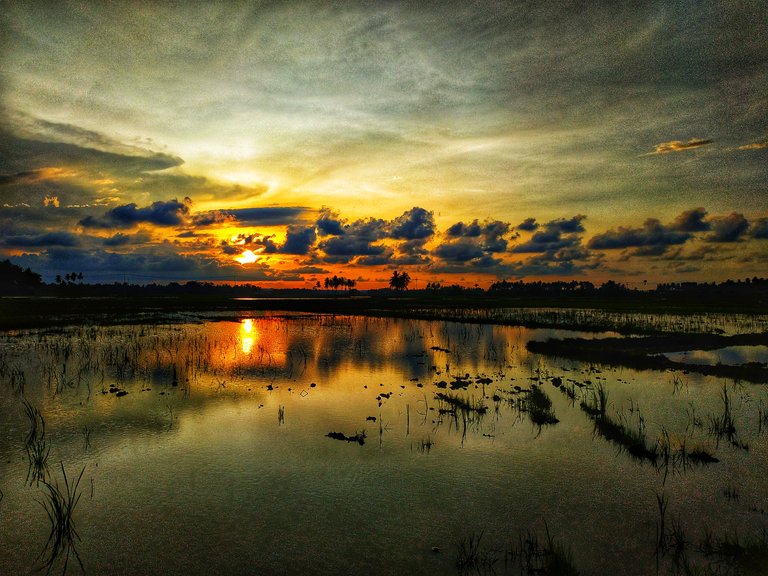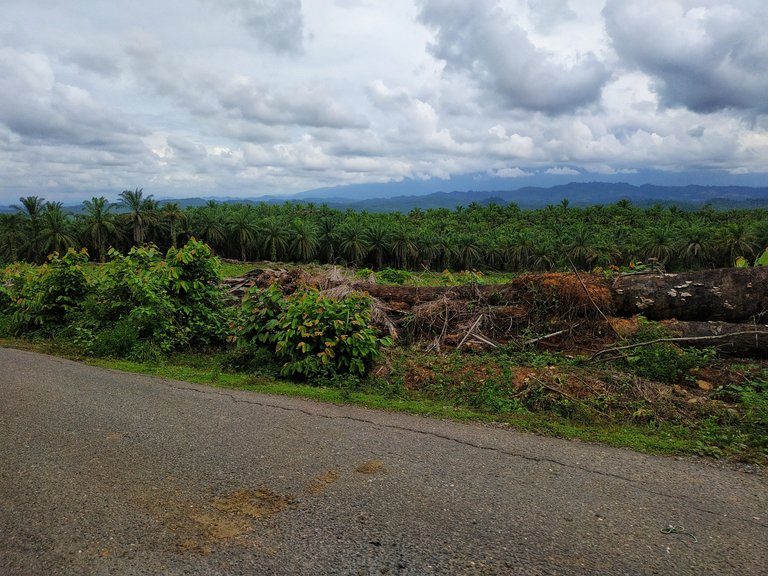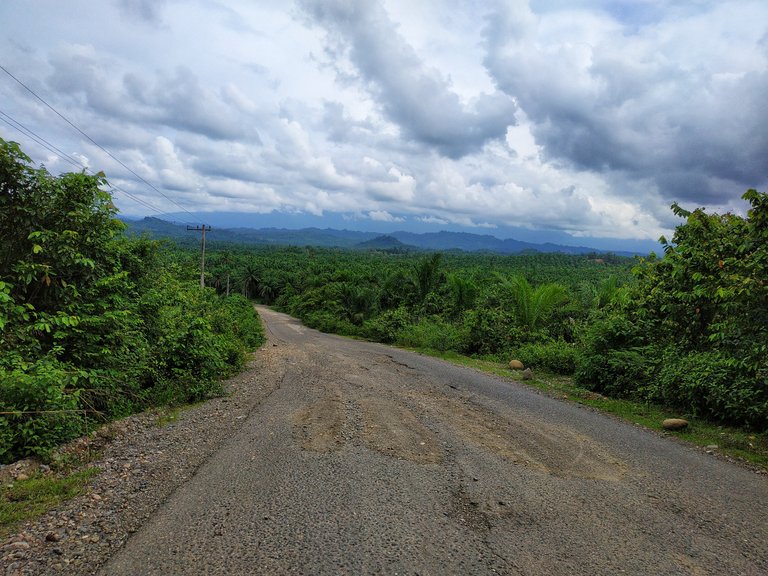The sun sets on the afternoon of May 27, 2020
The sun sets on the afternoon of May 27, 2020, when I cleaned the rice fields in my city, after finishing cleaning the fields, the sun seemed to shine with natural beauty, then I rushed to my own two-wheeled vehicle to take my cellphone in Bekasi so I took photos. beautiful sunset views that look very beautiful.
This is my rice field which looks radiated by the sunset which is almost finished to plant rice.

The natural beauty of the agricultural field located in my hometown

One of the objectives of conducting plantations is to improve the welfare and prosperity of the people, by promoting the principle of environmental functions. Although then achieving these goals does not become an absolute burden on the oil palm plantation sector alone, it also becomes an overall burden on holding plantations in general. However, for the Aceh context the achievement of these objectives must be the main focus of oil palm plantations. Why? Because in terms of land tenure, palm oil commodity is ranked first in the plantation sector in Aceh reaching 39.43%. Compared to rubber commodities 15.29%, coffee 12.28%, coconuts 10.34%, kakou 10.34%, then 7.04% for nutmeg, candlenut, cloves, and sugarcane. Walhi Aceh noted that the control of space / area for the plantation sector reached 1,195,528 ha, consisting of large plantations of 385,435 ha and community plantations of 810,093 ha (2015 Environmental Management Footprint).
Poverty Rate in Aceh
Improving the welfare and prosperity of the people is a sentence that is quite easy to say, not only a promise of regulation but the main goal of the political promise of regional leaders. In the aspect of plantations, surely the right measuring tool must be found in measuring the "welfare and prosperity". Because until now not yet found the right answer related to the question "how much influence the oil palm plantations (HGU) in reducing poverty in Aceh?". Although there is still debate between the pros and cons of oil palm in Aceh in answering that question, it is certain that in 2015 poverty rates will increase in Aceh.
In March 2015, the number of poor people (population with per capita expenditure per month below the Poverty Line) in Aceh reached 851 thousand people (17.08 percent), an increase of 14 thousand compared to the poor population in September 2014 which numbered 837 thousand people (16.98 percent). During the period September 2014 - March 2015, the percentage of poor people in urban areas decreased by 0.23 percent (from 11.36 percent to 11.13 percent), and in rural areas it experienced an increase of 0.25 percent (from 19.19 percent to 19.44 percent). The role of food commodities towards the Poverty Line is greater than the role of non-food commodities (housing, clothing, education, and health). Contribution of Food Poverty Line to Poverty Line in March 2015 was 75.97 percent while in September 2014 it was 76.52 percent (BPS: Aceh Province Poverty Profile March 2015).
Increasing poverty in 2015 must be an important lesson for the Government of Aceh. With the wealth of natural resources in Aceh these conditions should not occur and there should be a reduction in poverty rates. Of course there is a wrong approach in managing the wealth, including the management of the oil palm plantation sub-sector in Aceh. If you may assume, maybe holding oil palm plantations through plantation companies (HGU) is part of the poverty problem in Aceh? The proof, some areas in Aceh which control large oil palm plantation lands in numbers, the people are also not prosperous and prosperous.
Plantation Case
On the contrary, the rampant case of plantations seems to justify the assumptions above, and is evidence of the implementation of plantations in Aceh is still far from the expectations of Law No. 39 of 2014. The expansion of oil palm plantations with various cases that occurred in Aceh has had a serious economic, social and ecological impact. The case of land disputes between residents and plantation companies, for example, which until today has not been resolved, and instead seemed to have allowed omission by the local government. What is the amount of agricultural land / plantations of citizens who are lost, whether based on rights or have reduced community management space.
In addition, social conflicts, animal conflicts, forest damage, dry wells of citizens, reduced water debit, environmental pollution, waste, loss of human life, trauma, village famine, "slavery" in the labor scenario, and disasters are forms of loss be inflicted. The question then is, does the government calculate the loss rate? Comparable to the level of regional income received? Of course it is difficult to find an answer if it is associated with political interests and partiality towards entrepreneurs in every plantation licensing policy in Aceh. Thus, the community remains a disadvantaged party while entrepreneurs and political elites benefit.

This is where my daily work activities that always bring blessings from extraordinary plants, hopefully now will get more results than before we humans can only pray for the safety and pests of plants and animals roam, hopefully given abundant Rezky given
Landscape in North Aceh district
The natural wealth in Aceh is one of our pride in the green nature of nature as we have shown below


The development and expansion of oil palm plantations is a process of conversion or conversion of functions and forms of land that changes the vast land landscape, causing damage to functions and environmental services. Changes in the landscape, especially forests, land, water bodies, lakes and rivers cover, limit and reduce the ability and access of indigenous peoples, rural areas and farmers in continuing and maintaining natural gifts that have been the tools and factors that are sources of livelihood, food and shelter they. Other influences on the condition and social life of the community due to mastery and competition which increasingly reduce and forcibly change the identity, habits and wisdom of the community such as reduced or closed rights and access, livelihoods, cultural and religious values, mobilization of workers from outside with the presence of oil palm plantations and mills.
Palm oil was first introduced in Indonesia by the Dutch colonial government in 1848. At that time there were four oil palm seeds brought by Mauritius from Amsterdam and planted in the Bogor Botanical Gardens. Oil Palm began to be cultivated and commercially cultivated in 1911 in Aceh and North Sumatra by Adrien Hallet, a Belgian national. The area of oil palm plantations continues to increase from year to year. The first oil palm plantations are located on the East Coast of Sumatra (Deli) and Aceh. The area of the plantation is 5,123 ha. Until 2015 oil palm plantations in Indonesia have reached 11.44 million hectares, but Aceh is currently in the ninth position of national-level oil palm plantations. However, in the context of Aceh the expansion of oil palm plantations continues to grow and has reached 393,270 ha in 2014 or around 39.43% of land acquisition from other commodities.

Only this that we can collect may be useful, thank you for your visit to our blog.
What amazing photography shoot, great dude